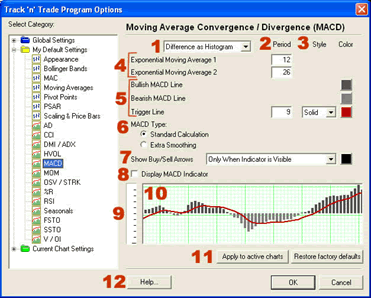
1. The MACD indicator can be displayed differently, choose from
Difference as Histogram or Difference as Line in the drop down menu.
2. Period: To specify the number of days used in calculating the
MACD simply click on the box, highlight the current number, and type in
a new value.
3. Style & Color: MACD Trigger line can be displayed as a solid or
dotted line. Click on the drop down menu to specify the type of line
style. Click on the color box and a color panel will open for you to
specify the new color.
4. The MACD is calculated using two exponential moving averages. To
change the periods used in the formula, highlight the number value and
type in the new value desired.
5. There are three components that create the MACD Indicator;
Bullish, Bearish and Trigger lines. More information on how these
components are calculated in the Using Indicators section under
MACD.
6. MACD Type: Choose from two types of MACD Indicators.
a. Standard Calculation
b. Extra Smoothed: This calculation is a proprietary formula
developed by Lan H. Turner, president and founder of Gecko Software,
Inc., and Gecko Software's Programming staff. This method increases the
movement in the MACD indicator and has shown to be more accurate (in
Gecko Software's market testing) than the standard calculation. Click
the Extra Smoothed option to test it's accuracy for yourself! Its
relationship to the MACD is similar to the relationship between the Fast
and Slow Stochastics - so think of this indicator as the "Fast MACD".
7. To display the Buy signal the MACD line needs to cross above the
Trigger line and the cross needs to occur above zero. To display a Sell
signal the MACD line needs to cross below the Trigger line and the cross
needs to occur below zero. If the Trigger Line Style is "None", then the
MACD arrows are determined with the crossing of the MACD line over zero.
To buy, the MACD line will go above zero and to sell, it will drop below
zero. The drop-down menu for Show Buy/Sell Arrows allows you to select
either "Always Show Arrows" or "Only When Indicator is Visible" to view
the buy/sell signals, or "Never Show Arrows" to never see the MACD
arrows.
8. To Display the indicator in the chart window, click the check
box.
9. Ruler Bar: See the Ruler Bar section at the end of this
chapter.
10. Preview Window: This window allows you to make changes and
preview them before saving.
11. Click on "Apply to Active Charts" if you would like to see your
selected settings on all the charts you have open. Click on "Restore
Factory Defaults" if you would like to restore original software
settings.
12. Help: Information from the manual has been integrated into
the software. When clicking on the "Help" button you will get specific
documentation based on the location of the button. You may also press F1
on your keyboard to access this information.
Back To Top |
|